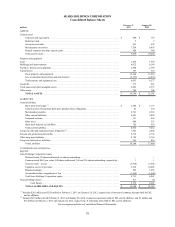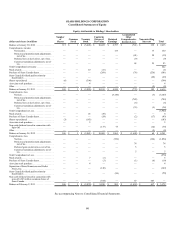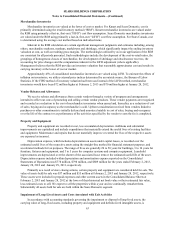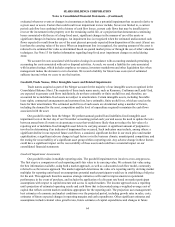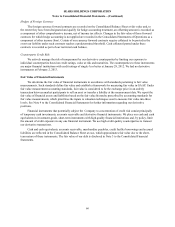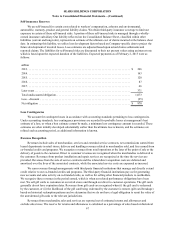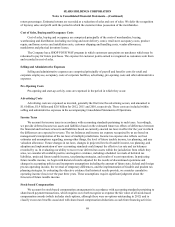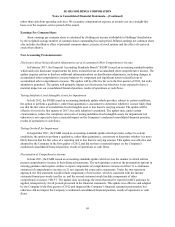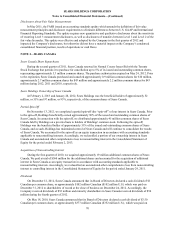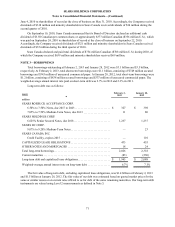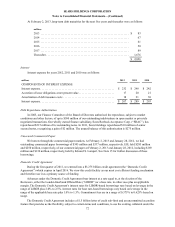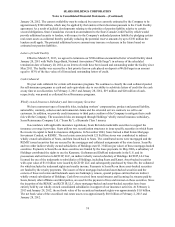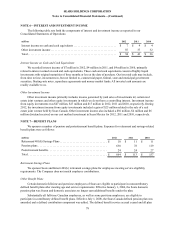Sears 2012 Annual Report Download - page 68
Download and view the complete annual report
Please find page 68 of the 2012 Sears annual report below. You can navigate through the pages in the report by either clicking on the pages listed below, or by using the keyword search tool below to find specific information within the annual report.SEARS HOLDINGS CORPORATION
Notes to Consolidated Financial Statements—(Continued)
68
return percentages. Estimated returns are recorded as a reduction of sales and cost of sales. We defer the recognition
of layaway sales and profit until the period in which the customer takes possession of the merchandise.
Cost of Sales, Buying and Occupancy Costs
Cost of sales, buying and occupancy are comprised principally of the costs of merchandise, buying,
warehousing and distribution (including receiving and store delivery costs), retail store occupancy costs, product
repair, and home service and installation costs, customer shipping and handling costs, vendor allowances,
markdowns and physical inventory losses.
The Company has a SHOP YOUR WAY program in which customers earn points on purchases which may be
redeemed to pay for future purchases. The expense for customer points earned is recognized as customers earn them
and recorded in cost of sales.
Selling and Administrative Expenses
Selling and administrative expenses are comprised principally of payroll and benefits costs for retail and
corporate employees, occupancy costs of corporate facilities, advertising, pre-opening costs and other administrative
expenses.
Pre-Opening Costs
Pre-opening and start-up activity costs are expensed in the period in which they occur.
Advertising Costs
Advertising costs are expensed as incurred, generally the first time the advertising occurs, and amounted to
$1.6 billion, $1.9 billion and $2.0 billion for 2012, 2011 and 2010, respectively. These costs are included within
selling and administrative expenses in the accompanying Consolidated Statements of Operations.
Income Taxes
We account for income taxes in accordance with accounting standards pertaining to such taxes. Accordingly,
we provide deferred income tax assets and liabilities based on the estimated future tax effects of differences between
the financial and tax basis of assets and liabilities based on currently enacted tax laws in effect for the year in which
the differences are expected to reverse. The tax balances and income tax expense recognized by us are based on
management's interpretation of the tax laws of multiple jurisdictions. Income tax expense also reflects our best
estimates and assumptions regarding, among other things, the level of future taxable income, tax planning, and any
valuation allowance. Future changes in tax laws, changes in projected levels of taxable income, tax planning, and
adoption and implementation of new accounting standards could impact the effective tax rate and tax balances
recorded by us. In evaluating our ability to recover our deferred tax assets within the jurisdiction from which they
arise, we consider all available positive and negative evidence, including scheduled reversals of deferred tax
liabilities, projected future taxable income, tax planning strategies, and results of recent operations. In projecting
future taxable income, we begin with historical results adjusted for the results of discontinued operations and
changes in accounting policies and incorporate assumptions including the amount of future state, federal and foreign
pre-tax operating income, the reversal of temporary differences, and the implementation of feasible and prudent tax
planning strategies. In evaluating the objective evidence that historical results provide, we consider cumulative
operating income (loss) over the past three years. These assumptions require significant judgment about the
forecasts of future taxable income.
Stock-based Compensation
We account for stock-based compensation arrangements in accordance with accounting standards pertaining to
share-based payment transactions, which requires us to both recognize as expense the fair value of all stock-based
compensation awards (which includes stock options, although there were no options outstanding in 2012) and to
classify excess tax benefits associated with share-based compensation deductions as cash from financing activities


